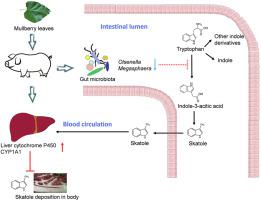当前位置:
X-MOL 学术
›
Anim. Nutr.
›
论文详情
Our official English website, www.x-mol.net, welcomes your feedback! (Note: you will need to create a separate account there.)
Mulberry leaf supplementation inhibits skatole deposition by regulating gut microbiota and upregulating liver cytochrome P450 1A1 expression in finishing pigs
Animal Nutrition ( IF 6.3 ) Pub Date : 2023-10-19 , DOI: 10.1016/j.aninu.2023.05.018 Yuqing Sun , Xiaoming Men , Tianbao Lin , Bo Deng , Shi Zhong , Jinxi Huo , Kaipeng Qin , Zhiqiang Lv , Ziwei Xu , Yougui Li
Animal Nutrition ( IF 6.3 ) Pub Date : 2023-10-19 , DOI: 10.1016/j.aninu.2023.05.018 Yuqing Sun , Xiaoming Men , Tianbao Lin , Bo Deng , Shi Zhong , Jinxi Huo , Kaipeng Qin , Zhiqiang Lv , Ziwei Xu , Yougui Li

|
Skatole, a strong fecal odor substance, is generated through microbial degradation of tryptophan in the animal hindgut. It easily accumulates in adipose tissue and affects meat quality. In this study, the effect of mulberry leaf supplementation on skatole in finishing pigs was studied. In a 35-day trial, 20 finishing pigs (barrows and gilts) were fed with a basal diet or basal diet with 6% mulberry leaves. Growth performance of the pigs ( = 10) was automatically recorded by a performance-testing feeder system and 8 pigs in each treatment were slaughtered and sampled for the remaining tests. Skatole and short-chain fatty acids were detected using HPLC and gas chromatography, respectively. Fecal microbiota were analyzed using 16S rRNA gene sequencing. The metabolomics analysis of feces and serum was performed with UHPLC-MS/MS. The major cytochrome P450 (CYP) enzymes that catalyze skatole degradation in the liver were tested by using RT-PCR and Western blot. Effects of major bioactive compounds in mulberry leaves on the genes were verified in the hepatic cell line HepG2 in an in vitro test ( = 3). In finishing pigs, mulberry leaf supplementation had no significant effect on the average daily gain, average daily feed intake, and feed conversion ratio ( > 0.05), but reduced skatole levels in feces, serum, and backfat ( < 0.05), and increased acetic acid levels in feces ( = 0.027). Mulberry leaf supplementation decreased the relative abundance of the skatole-producing bacteria and ( < 0.05). Indole-3-acetic acid, the intermediate that is essential for skatole production, was significantly reduced in feces by mulberry leaf supplementation ( < 0.05) and was positively correlated with skatole content in feces ( = 0.004). In pigs treated with mulberry leaves, liver expression was increased ( < 0.05) and was negatively correlated with skatole content in backfat ( = 0.045). The in vitro test demonstrated that mulberry leaf polyphenols and polysaccharides could directly stimulate expression in hepatic cells. These findings suggest that mulberry leaf supplementation reduces skatole production and deposition in finishing pigs by regulating the gut microbiota and promoting skatole degradation in liver.
中文翻译:

桑叶补充剂通过调节育肥猪肠道微生物群和上调肝细胞色素 P450 1A1 表达来抑制粪臭素沉积
粪臭素是一种强烈的粪便气味物质,是通过动物后肠中色氨酸的微生物降解而产生的。它容易在脂肪组织中积聚,影响肉质。本研究研究了补充桑叶对育肥猪粪臭素的影响。在为期 35 天的试验中,20 头育肥猪(阉猪和后备母猪)饲喂基础日粮或添加 6% 桑叶的基础日粮。猪的生长性能(= 10)由性能测试饲养系统自动记录,每个处理中的 8 头猪被屠宰并取样用于其余测试。分别使用 HPLC 和气相色谱法检测粪臭素和短链脂肪酸。使用 16S rRNA 基因测序分析粪便微生物群。采用 UHPLC-MS/MS 进行粪便和血清的代谢组学分析。通过 RT-PCR 和 Western blot 测试了肝脏中催化粪臭素降解的主要细胞色素 P450 (CYP) 酶。桑叶中主要生物活性化合物对基因的影响在体外试验的肝细胞系 HepG2 中得到了验证 (= 3)。在育肥猪中,添加桑叶对平均日增重、平均日采食量和饲料转化率没有显着影响(>0.05),但降低了粪便、血清和背膘中粪臭素水平(<0.05),并增加了乙酸粪便中的酸含量 (= 0.027)。补充桑叶降低了粪臭素产生细菌的相对丰度 (<0.05)。吲哚-3-乙酸是粪臭素生产所必需的中间体,通过补充桑叶,粪便中的吲哚-3-乙酸显着减少(<0.05),并且与粪便中粪臭素含量呈正相关(=0.004)。在用桑叶处理的猪中,肝脏表达增加(<0.05),并且与背膘中粪臭素含量呈负相关(=0.045)。体外试验表明,桑叶多酚和多糖可以直接刺激肝细胞表达。这些发现表明,桑叶补充剂通过调节肠道微生物群和促进肝脏中粪臭素降解,减少育肥猪粪臭素的产生和沉积。
更新日期:2023-10-19
中文翻译:

桑叶补充剂通过调节育肥猪肠道微生物群和上调肝细胞色素 P450 1A1 表达来抑制粪臭素沉积
粪臭素是一种强烈的粪便气味物质,是通过动物后肠中色氨酸的微生物降解而产生的。它容易在脂肪组织中积聚,影响肉质。本研究研究了补充桑叶对育肥猪粪臭素的影响。在为期 35 天的试验中,20 头育肥猪(阉猪和后备母猪)饲喂基础日粮或添加 6% 桑叶的基础日粮。猪的生长性能(= 10)由性能测试饲养系统自动记录,每个处理中的 8 头猪被屠宰并取样用于其余测试。分别使用 HPLC 和气相色谱法检测粪臭素和短链脂肪酸。使用 16S rRNA 基因测序分析粪便微生物群。采用 UHPLC-MS/MS 进行粪便和血清的代谢组学分析。通过 RT-PCR 和 Western blot 测试了肝脏中催化粪臭素降解的主要细胞色素 P450 (CYP) 酶。桑叶中主要生物活性化合物对基因的影响在体外试验的肝细胞系 HepG2 中得到了验证 (= 3)。在育肥猪中,添加桑叶对平均日增重、平均日采食量和饲料转化率没有显着影响(>0.05),但降低了粪便、血清和背膘中粪臭素水平(<0.05),并增加了乙酸粪便中的酸含量 (= 0.027)。补充桑叶降低了粪臭素产生细菌的相对丰度 (<0.05)。吲哚-3-乙酸是粪臭素生产所必需的中间体,通过补充桑叶,粪便中的吲哚-3-乙酸显着减少(<0.05),并且与粪便中粪臭素含量呈正相关(=0.004)。在用桑叶处理的猪中,肝脏表达增加(<0.05),并且与背膘中粪臭素含量呈负相关(=0.045)。体外试验表明,桑叶多酚和多糖可以直接刺激肝细胞表达。这些发现表明,桑叶补充剂通过调节肠道微生物群和促进肝脏中粪臭素降解,减少育肥猪粪臭素的产生和沉积。



























 京公网安备 11010802027423号
京公网安备 11010802027423号